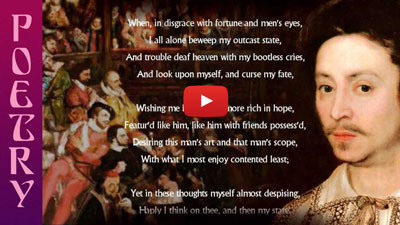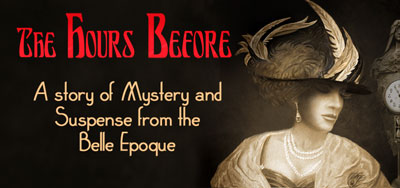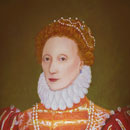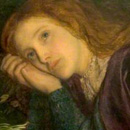‘When, in disgrace with fortune’
Transcript - Sonnet 29
When, in disgrace with fortune and men's eyes,
I all alone beweep my outcast state,
And trouble deaf heaven with my bootless cries,
And look upon myself, and curse my fate,
Wishing me like to one more rich in hope,
Featur'd like him, like him with friends possess'd,
Desiring this man's art and that man's scope,
With what I most enjoy contented least;
Yet in these thoughts myself almost despising,
Haply I think on thee, and then my state,
Like to the lark at break of day arising
From sullen earth, sings hymns at heaven's gate;
For thy sweet love remember'd such wealth brings
That then I scorn to change my state with kings.
I all alone beweep my outcast state,
And trouble deaf heaven with my bootless cries,
And look upon myself, and curse my fate,
Wishing me like to one more rich in hope,
Featur'd like him, like him with friends possess'd,
Desiring this man's art and that man's scope,
With what I most enjoy contented least;
Yet in these thoughts myself almost despising,
Haply I think on thee, and then my state,
Like to the lark at break of day arising
From sullen earth, sings hymns at heaven's gate;
For thy sweet love remember'd such wealth brings
That then I scorn to change my state with kings.
Sonnet 29 - insights, themes and ideas for interpretation
● Sonnet 29 is essentially a love poem
● The sentiments expressed in the first stanza of the video are familiar territory for most - especially at times of misfortune or sorrow when it is tempting to perceive others as being more successful, more popular and better connected than oneself.
● The poet wishes he might possess the opportunities, the friends and even the features of others more highly regarded.
● He has a significant change of heart, however, during the final stanza when he thinks on the person he loves and who, it is presumed, does admire and value him in return.
● The thought of his beloved has an uplifting quality. It overcomes the self-indulgent introspection of the previous lines, and allows the poet to rise above petty jealousies and personal inadequacies towards a state of euphoria.
● So great is the extent of his feelings that it outweighs even the greatest worldly temptations. He would not even change his state with a king.
● The redeeming power of love.
● The sentiments expressed in the first stanza of the video are familiar territory for most - especially at times of misfortune or sorrow when it is tempting to perceive others as being more successful, more popular and better connected than oneself.
● The poet wishes he might possess the opportunities, the friends and even the features of others more highly regarded.
● He has a significant change of heart, however, during the final stanza when he thinks on the person he loves and who, it is presumed, does admire and value him in return.
● The thought of his beloved has an uplifting quality. It overcomes the self-indulgent introspection of the previous lines, and allows the poet to rise above petty jealousies and personal inadequacies towards a state of euphoria.
● So great is the extent of his feelings that it outweighs even the greatest worldly temptations. He would not even change his state with a king.
● The redeeming power of love.
Technical info’
Type of Poem =
a Shakespearean Sonnet, a 14-line poem - a sonnet being a poem that develops its message as it goes, often with an unusual twist and ultimately reaching a satisfying conclusion. There are three 4-line stanzas in this kind of contruction, followed by a final couplet (two rhyming lines).Rhyme Scheme =
ABAB CDCD EFEF GG.Meter =
iambic pentameter (5 stressed and 5 unstressed syllables per line).Fictional Memoir
Historical Novel
Classic Poetry
Victorian Gothic












